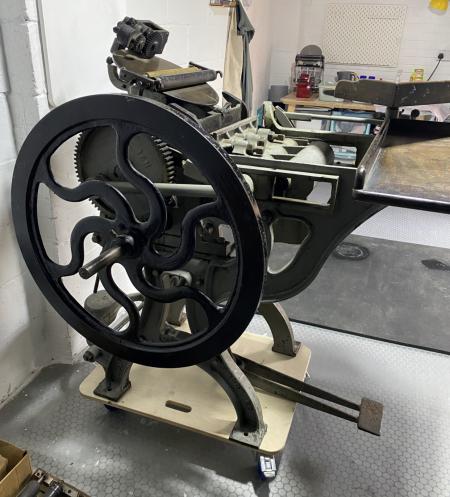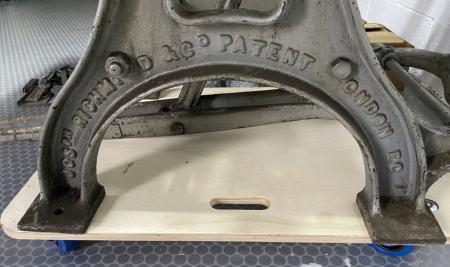Joseph Richmond Press?
Hello,
I have acquired a lovely press which I’m looking to restore but before diving in I would love to know what type of press it is.. I’ve done a fair bit of Googling and can’t find anything about Joseph Richmond presses, so I just don’t know how to identify this for things like parts. Any help would be very much appreciated!
Thanks
Sarah

D0831C5B-D466-4934-8632-5472598478A0.jpeg

BEE75458-36B9-47C5-9D52-FE3969E9C836.jpeg
That is a real rarity! I can not make out the location, it looks like London with the “L” covered by the bolt. It also looks to me like a unique parallel impression mechanism, which would make for good quality printing. My guess is you will not find much or anything about it. Where did you find it, and where are you? Have you turned it over through a printing cycle without any ink or type/blocks to print, to study the action? I would be very interested to know more about it and how it works.
Bob
Apologies for the double post!
Bob
Hi Bob, I think it is London, the Joseph is truncated too, and I’m assuming it’s Joseph, but you’re right - I have found literally nothing about this online and I’ve spent a good few hours trying!
I picked this up from an engineer based in northern England - he was dealing with an estate after a death in the family, he knew nothing about it (apart from it being heavy) - so after a bit of back and forth (and discussion on how to get it to me) we agreed on a price and she’s now in my garage in Bedfordshire.I have her on a sturdy dolly which can take 600kg+ and that’s mostly so I can move it while I’m getting her up and running.
I haven’t done a print run yet but I have a letterpress engineer coming this week to give her a service and balance etc. Im looking forward to printing with her :-) once the engineer has given her the once over I will know more about the mechanism.
Would love to know more on the history of it, if there are any others, etc. I was fortunate to find some lovely little goodies that came with it - lots of furniture, chases etc, but also some unexpected little bits and pieces!
06C14944-7B22-4351-9B0A-C873426CACD0.jpeg
ACA7409B-1A0B-4A9A-877A-2075AECC0BAF.jpeg
886A37A8-B0B5-41E7-ADED-D0F9255A50F1.jpeg
I realized after I posted that “EC” is a locater for London England. I forget what it means. It looks to me like the platen moves back and forth in that slot while tipping up as it moves back and back down as the press closes, pulling the platen in parallel with the bed and type. The usual job press mechanism is called “clamshell” because it opens and closes that way. Parallel impression presses are preferred for the finest letterpress work. Have you got at least one “chase”, the rectangular iron frame in which the type is locked up for printing? You will need at least one. Also, do you have any experience printing with these.what are called “jobbing” presses?
You might check with the Printing Historical Society at St. Bride Foundation in London. They have a fine library collection and may be able to turn up information about Joseph platen presses. They keep limited hours but are open I believe on Saturdays - check their website.
Bob
One other caution - depending on the size, difficult to guess in the photo, the press may weigh a good deal more than 600kg, so be very careful about rolling at around on that dolly — if the dolly breaks and the press falls on you… the presses I am acquainted with that are approximately that size typically weigh 1500-1800 lbs.
Bob
Found this:
Proceedings - Volume 46 - Page xxviii - Google Books Result
https://books.google.co.cr › books
Institution of Mechanical Engineers (Great Britain) · 1893 · Mechanical engineering
Joseph Richmond and Co. , 30 Kirby Street , Hatton Garden , London , E.C. 1874.
And this: 1889. Richmond, Joseph, New Sun Iron Works, Burdett Road, Bow, London, E. ; and 30 Kirby Street, Hatton Garden, London, E.C.
Seems likely he’s your man.
Bob
Thanks so much, Bob - that’s really helpful.
And thanks for the word of caution about the dolly - when I say it’s so I can move her - we’re talking literally only when I’m ready to set her down properly, and it will definitely not be me moving it (I’m 5ft!) so no need to worry about it falling. It took 3 strong bodied people to get it off the trailer and into the garage ☺️
The press came with 6 chases of varying sizes, and one which was still set up - the engineer is going to clean the press, check the oil ports, balance the platen and check everything is in order. I’ve got someone quoting for refurbing the rollers too.
In terms of experience, so far the only experience I have in terms of printing has been with my Adana 8x5 - a very different animal :-)
57D71670-C575-43BD-8896-C234230DAEFE.jpeg
You are very lucky to have gotten a treadle press to learn on - you can make it go very slowly as you learn the rythm of treadling and feeding at the same time, and while getting used to the reach for feeding and taking off. Most presses work better when the top of the flywheel is going away from the pressperson. Also makes it safer to stop the press by grabbing the flywheel, though I prefer to “jump” on the treadle, pressing on the upstroke, to stop and rock the press while fixing whatever went wrong.
I found it helpful to practice the rather complex combination of moves without type or ink, feeding and taking off blank paper until you have a feel for the process. It is a bit like climbing stairs while rubbing your head and patting your tummy all at the same time. Takes practice. :-)
the more I think about it the more I’m delighted with it - It was pure chance that I came across it, and I’m really looking forward to getting it seen by the engineer so I can get it closer to the point of printing!
My googling has turned up one entry on here: https://paekakarikipress.com/?content=jacobi.php
Hatton machine A small treadle platen machine made by Messrs. J. Richmond and Co. - J
do you think this could mean that the press I have is a Hatton machine?
A treadle platen operated an a wheeled platform is not ideal, much wasted movement during operation even if some wheels can be locked. If the press needs to be moved around, I would suggest placing solid timbers to raise the platform just enough for stability during treadling.
Hi parallel_imp, the wheeled dolly is literally only so I could move the press into the garage. The big black mat you can see in the background is where I’m going to set the press down for printing. It’s just on the dolly temporarily, and I have an engineer coming to set the press up properly - for which it will need to be on the ground on a level surface :-)
Good to hear that. I only bring it up because I have not only seen treadle platens kept up on wheels but even a Vandercook. People do take some extreme measures when fitting a print shop into a little space.
I can imagine! Thankfully I have a whole garage’s worth of space, literally just got a desk in the back and some storage to the side, but easily space to set her down properly and have space to move all the way round too.
I do appreciate the word of caution though :-) I am definitely not an expert!